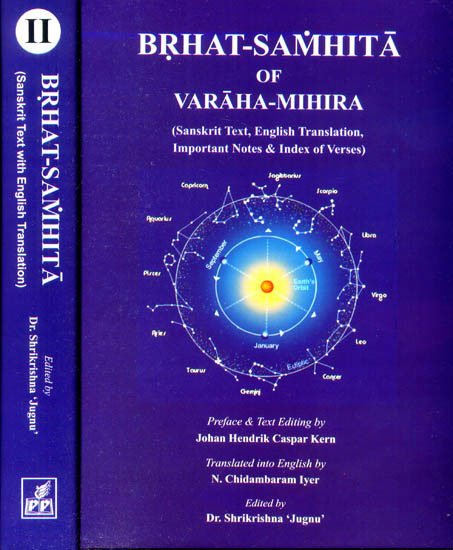Brihat Samhita
by N. Chidambaram Iyer | 1884 | 135,584 words | ISBN-13: 9788171104215
This page describes the course of mercury (budha-cara) which is the seventh Chapter of the English translation of the Brihat-samhita. This work, written by Varahamihira in the 6th century, is classified as jyotisha literature, also known as Indian astronomy. It contains however, also content regarding astrology, palmistry, agriculture, gardening, perfumes, medicines and various other encyclopedic topics.
Chapter 7 - On the course of Mercury (budha-cāra)
[Sanskrit text for this chapter is available]
1. Mercury (budha) never reappears[1] after his conjunction with the sun without upsetting the existing order of things: he causes fear from flood, from fire and from storms and paralizes trade by abnormally enhancing or lowering the price of food grains.
2. If Mercury should cut through the constellations of Śravaṇa, Dhaniṣṭhā, Rohiṇī, Mṛgaśīrṣa and Uttarāṣāḍha, sacred respectively to Viṣṇu, Aṣṭavasu, Brahmā, the Moon and Viśvedevā, his disc appearing to rub against those of the stars, he causes drought and disease in the land.
3. If Mercury should cut through the five constellations from Ārdrā to Maghā, mankind will suffer from wars, from hunger, from disease and from drought.
4. If he should cut through the six constellations from Hasta, his disc appearing to rub against those of the stars, cows will suffer, the price of liquid substances and of juice will rise, but there will be abundance of food grains in the land.
5. If he should cut through the constellations of Uttaraphālguni (sacred to Āryama, the Sun), of Kṛttikā (sacred to Agni, the fire), of Uttarabhadra and of Bharaṇi (sacred to Yama), all living creatures will be afflicted with disease in blood, in flesh, in bones and the like.
6. If he should cut through the constellations of Aśvinī (sacred to the Aśvinī Devas), of Śatabhiṣaja (sacred to Varuṇa), of Mūla and Revatī, tradesmen, physicians, boatmen, creatures of water and horses will suffer.
7. If he should cut through one of the constellations of Pūrvaphālguni, Pūrvāṣāḍha and Pūrvabhādra, mankind will suffer from hunger, from wars, from thieves and from disease.
8. In Parāśara’s work on Astronomy, Mercury has seven courses assigned to him; they are technically known as—1. Prākṛta, 2. Vimiśra, 3. Saṃkṣipta, 4. Tīkṣṇa, 5. Yogānta, 6. Ghora and 7. Pāpā.
9. If Mercury (budha) should pass through the constellations of Svāti, Bharaṇi, Roniṇi and Kṛttikā, sacred respectively to Vāyu, to Yama, to Pitāmaha and to Agni, his course is technically known as Prākṛta. If he should pass through the constellations of Mṛgaśīrṣa, Ārdrā, Maghā, Aśleṣā, sacred respectively to the Moon, to Siva, to the Pitṛs and to the serpent, his course is known as Miśragati.
10. If Mercury should pass through the constellations of Puṣya, Punarvasu and the two Phālgunis, his course is known as Saṃkṣipta. If he should pass through the constellations of the two Bhādrapadas, of Viśākhā, of Aśvinī and of Revatī, his course is known as Tīkṣṇa.
11. If Mercury should pass through the constellations of Mūla and the two Āṣāḍhas, his course is known as Yogāntika. If such course should lie through the constellations of Śravaṇa, Citrā, Dhaniṣṭhā and Stvāṣṭra, it is known as Ghora.
12. If Mercury should pass through the constellations of Hasta, Anurādhā, Jyeṣṭhā, sacred respectively to the Sun, to Mitra and to Indra, his course is known as Pāpa. We now proceed to state the periods, in days, of the effects of Mercury’s reappearance in, and course through, particular lunar mansions.
13. The effects of the Prākṛta and other courses of Mercury described above will last respectively for 40, 30, 22, 18, 9, 15 and 11 days.
14. When Mercury is in his Prākṛta course, there will be increase of health, of rain, of crops and there will be prosperity in the land. If he should be either in his Saṃkṣipta or Miśra course, mankind will be partly happy and partly miserable. When in his remaining four courses, Mercury brings on adversity.
15. According to Devata, the effects of the Ṛjvya (direct), the Ativakra (over retrograde), the Vakra (retrograde) and the Vikala (of irregular rate) motions of Mercury will last respectively for 30, 24, 12 and 6 days.
16. When Mercury is in his Ṛjvya course, mankind will be happy; when in his Ativakra course he will destroy wealth; when he is in his Vakra course there will be wars in the land; and when he is in his Vikala course mankind will be afflicted with fear and disease.
17. If Mercury should, after his conjunction with the Sun, reappear in the month of Āṣāḍha or Śrāvaṇa or Vaiśākha or Māgha, there will be fear in the land; but if he should be in his course in those months there will be happiness in the land.
18. If Mercury should so reappear in the month of Kārttika or Aśvayuja, there will be wars in the land and mankind will suffer from robbers, from fire, from disease, from flood and from hunger.
19. When Mercury should disappear, the chief towns in the land will be besieged by enemies, but when he reappears the siege will be raised. According to some writers, the latter occurs only when Mercury reappears as an evening star; and learned writers also say that the chief rulers will also get an accession of territories.
20. If Mercury should be of the colour of gold or of a parrot or if he should resemble the hue of the Sasyaka[2] gem, or if his disc should appear glossy or big in size, mankind will be happy; but if otherwise, they will be afflicted with miseries.
Footnotes and references:
[1]:
Mercury disappears when within 14 degrees from the Sun and re-appears beyond that distance; but when retrograde, the limit is only 12 degrees.
[2]:
Sasyaka: a species of precious stone coloured like the inner fruit of a coconut; perhaps an opal.
